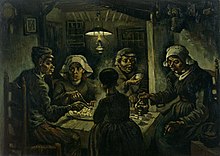Geoffrey de Ste Croix
Geoffrey Ernest Maurice de Sainte Croix (born February 8, 1910 in Macau , † February 5, 2000 in Oxford , England ) was a British ancient historian .
Life
He left school in 1925, at the age of 15, where he had received intensive lessons in ancient languages but no history training. He then worked in the legal business. He was also an active tennis player and was under-16 champions of southern England. From 1930 to 1932 he competed annually at Wimbledon . In a less important tournament, he defeated Fred Perry . In 1932 he ended his tennis career.
During the Second World War he served in the Royal Air Force and was stationed in Tripolitania , where he was particularly fascinated by the archaeological sites just excavated in Cyrene . This and the reading of works by George Derwent Thomson , for example, motivated him to give up his professional activity and to start studying classical studies at the age of 37. He graduated from University College London , where Arnold Hugh Martin Jones was his academic teacher. He then worked for a year with Arnaldo Momigliano , Jones' successor in London. From 1950 to 1953 he taught at the London School of Economics and Political Science . He then became a tutor at New College , Oxford , where he remained until his retirement in 1977. In 1972 he was elected a member of the British Academy .
plant
In his works, which were heavily influenced by Karl Marx , Geoffrey de Ste Croix consistently sided with the working and oppressed classes of the population and thus clearly moved away from the view of history that had prevailed until then (especially in the western industrialized nations), which reflected the standpoint of the upper class . His book The Origins of the Peloponnesian War is considered one of the standard works on the Peloponnesian War .

In 1981 he published The Class Struggle in the Ancient Greek World , which spans a wide range from the archaic period to late antiquity and ends with an attempt to explain the fall and fall of the Roman Empire. It includes a detailed study of ancient Greek society using Marxist terms such as class , mode of production and exploitation . Ste. Croix comes to the conclusion that a very small group (2-3% of the total population) can be described as the exploiting class (especially landowners) who have faced a large group of exploited wage laborers and forced laborers (e.g. slaves). In between, in his opinion, a kind of middle class formed by far the largest group, consisting mainly of smaller farmers, artisans and traders. This largest group of the population very rarely exploited wage laborers or slaves and, in turn (especially in the classical democracies) was only rarely exploited by the small upper class; this changed in Greece only under Roman hegemony : Rome now allowed the upper class to exploit the rest of the population. Against this background, the greater part of ancient Greek history can be interpreted as "class struggle on a political level". Ste. Croix also pointed out that our image of antiquity was disproportionately shaped by the literary works of the small group of the upper class.
Fonts (selection)
- The Origins of the Peloponnesian War . Duckworth, London 1972, ISBN 0-7156-0640-9 .
- The Class Struggle in the Ancient Greek World. From the Archaic Age to the Arab Conquests . Duckworth, London 1981, ISBN 0-7156-1701-X .
- Athenian democratic origins and other essays. Edited by David Harvey and Robert Parker. Oxford University Press, Oxford et al. 2004, ISBN 0-19-925517-2 .
literature
- Paul A. Cartledge , F. David Harvey (Eds.): Crux. Essays Presented to GEM de Ste. Croix on his 75th birthday. Duckworth, in association with Imprint Academic, London 1985, ISBN 0-7156-2092-4 .
- Ὁ ἀρχαῖος κόσμος σήμερα (συνέντευξη τοῦ GEM de Ste.Croix). In: Horos. Volume 6, 1988, pp. 123-133 (English-language interview with de Ste Croix).
- Robert Parker : Geoffrey Ernest Maurice de Ste. Croix 1910-2000. In: Proceedings of the British Academy. Vol. 111, 2001, pp. 447-478, digitized version (PDF; 792 kB) .
Web links
- Obituary on www.wsws.org (engl.)
- Obituary www.guardian.co.uk (Engl.)
Individual evidence
- ^ Deceased Fellows. British Academy, accessed May 19, 2020 .
| personal data | |
|---|---|
| SURNAME | De Ste Croix, Geoffrey |
| ALTERNATIVE NAMES | De Sainte Croix, Geoffrey Ernest Maurice |
| BRIEF DESCRIPTION | British ancient historian |
| DATE OF BIRTH | February 8, 1910 |
| PLACE OF BIRTH | Macau |
| DATE OF DEATH | February 5, 2000 |
| Place of death | Oxford |